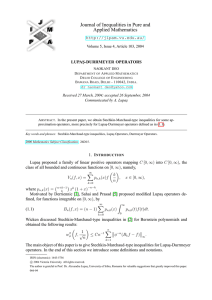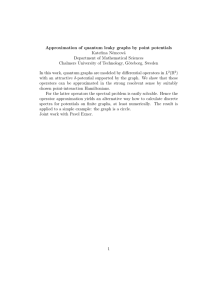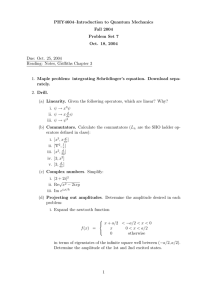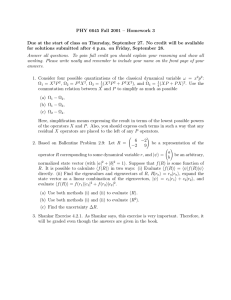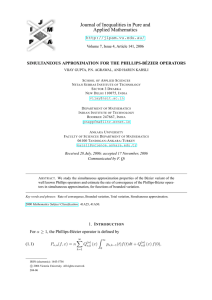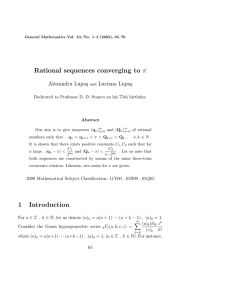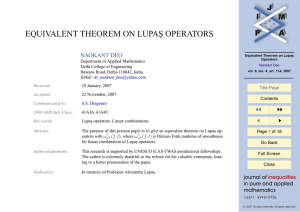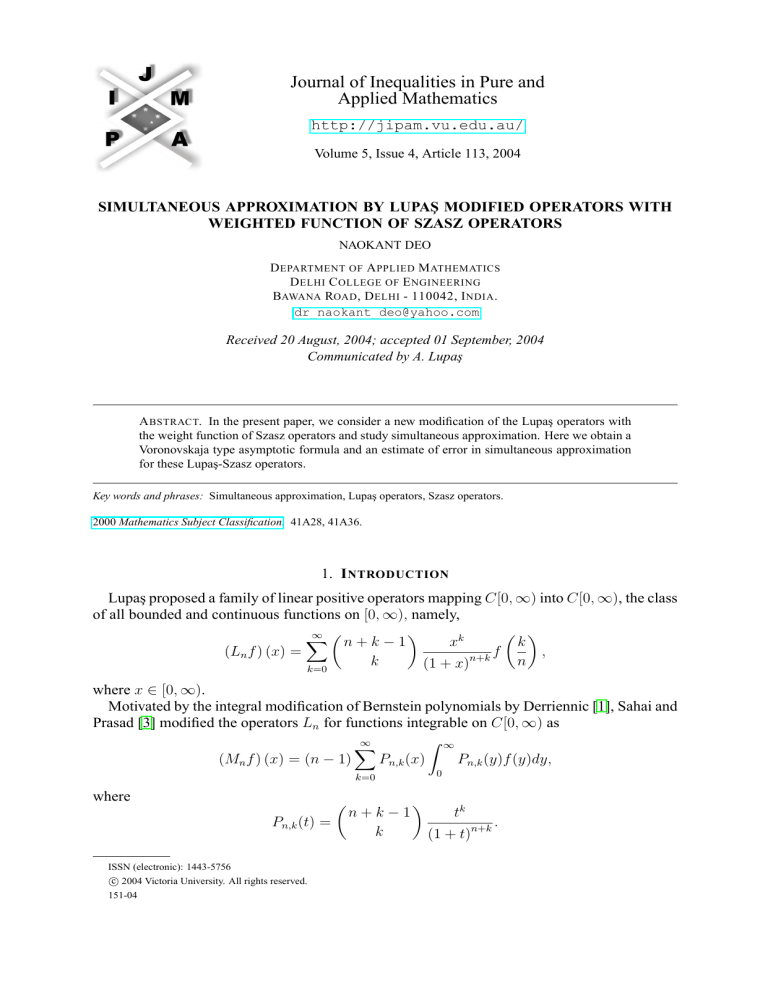
Journal of Inequalities in Pure and
Applied Mathematics
http://jipam.vu.edu.au/
Volume 5, Issue 4, Article 113, 2004
SIMULTANEOUS APPROXIMATION BY LUPAŞ MODIFIED OPERATORS WITH
WEIGHTED FUNCTION OF SZASZ OPERATORS
NAOKANT DEO
D EPARTMENT OF A PPLIED M ATHEMATICS
D ELHI C OLLEGE OF E NGINEERING
BAWANA ROAD , D ELHI - 110042, I NDIA .
dr_naokant_deo@yahoo.com
Received 20 August, 2004; accepted 01 September, 2004
Communicated by A. Lupaş
A BSTRACT. In the present paper, we consider a new modification of the Lupaş operators with
the weight function of Szasz operators and study simultaneous approximation. Here we obtain a
Voronovskaja type asymptotic formula and an estimate of error in simultaneous approximation
for these Lupaş-Szasz operators.
Key words and phrases: Simultaneous approximation, Lupaş operators, Szasz operators.
2000 Mathematics Subject Classification. 41A28, 41A36.
1. I NTRODUCTION
Lupaş proposed a family of linear positive operators mapping C[0, ∞) into C[0, ∞), the class
of all bounded and continuous functions on [0, ∞), namely,
∞ X
k
n+k−1
xk
(Ln f ) (x) =
f
,
n+k
k
n
(1
+
x)
k=0
where x ∈ [0, ∞).
Motivated by the integral modification of Bernstein polynomials by Derriennic [1], Sahai and
Prasad [3] modified the operators Ln for functions integrable on C[0, ∞) as
Z ∞
∞
X
(Mn f ) (x) = (n − 1)
Pn,k (x)
Pn,k (y)f (y)dy,
0
k=0
where
Pn,k (t) =
ISSN (electronic): 1443-5756
c 2004 Victoria University. All rights reserved.
151-04
n+k−1
k
tk
(1 + t)n+k
.
2
NAOKANT D EO
Integral modification of Szasz-Mirakyan operators were studied by Gupta [2]. Now we consider
another modification of Lupaş operators with the weight function of Szasz operators, which are
defined as
Z ∞
∞
X
(1.1)
(Bn f ) (x) = n
Pn,k (x)
Sn,k (y)f (y)dy
0
k=0
where
Pn,k (x) =
n+k−1
k
and
Sn,k (y) =
xk (1 + x)−n−k
e−ny (ny)k
.
k!
2. BASIC R ESULTS
The following lemmas are useful for proving the main results.
Lemma 2.1. Let m ∈ N 0 , n ∈ N, if we define
Z
∞
X
Tn,m (x) = n
Pn+r,k (x)
∞
Sn,k+r (y)(y − x)m dy
0
k=0
then
(i) Tn,0 (x) = 1, Tn,1 (x) =
Tn,2 (x) =
(2.1)
1+r(1+x)
,
n
and
rx(1 + x) + 1 + [1 + r(1 + x)]2 + nx(2 + x)
n2
(ii) For all x ≥ 0,
Tn,m (x) = O
1
n[
m+1
2
]
.
(iii)
(1)
nTn,m+1 (x) = x(1 + x)Tn,m+1 (x) + [m + 1 + r(1 + x)]Tn,m (x) + mxTn,m−1 (x)
where m ≥ 2.
Proof. The value of Tn,0 (x), Tn,1 (x) easily follows from the definition, we give the proof of (iii)
as follows.
Z ∞
∞
X
(1)
(1)
x(x + 1)Tn,m (x) = n
x(1 + x)Pn+r,k (x)
Sn,k+r (y)(y − x)m dy
0
k=0
− mn
∞
X
Z
x(1 + x)Pn+r,k (x)
∞
Sn,k+r (y)(y − x)m−1 dy.
0
k=0
Now using the identities
(1)
ySn,k (y) = (k − ny)Sn,k (y),
(1)
and x(1 + x)Pn,k (x) = (k − nx)Pn,k (x), we get
(1)
x(1 + x)Tn,m
(x)
Z
∞
X
=n
[k − (n + r)x]Pn+r,k (x)
k=0
J. Inequal. Pure and Appl. Math., 5(4) Art. 113, 2004
∞
Sn,k+r (y)(y − x)m dy − mx(1 + x)Tn,m−1 (x).
0
http://jipam.vu.edu.au/
S IMULTANEOUS A PPROXIMATION BY L UPA Ş M ODIFIED O PERATORS
3
Therefore,
(1)
x(1 + x)[Tn,m
(x) + mTn,m−1 (x)]
Z ∞
∞
X
=n
Pn+r,k (x)
[(k + r − ny) + n(y − x) − r(1 + x)]Sn,k+r (y)(y − x)m dy
=n
=n
k=0
∞
X
k=0
∞
X
0
∞
Z
(1)
ySn,k+r (y)(y − x)m dy + nTn,m+1 (x) − r(1 + x)Tn,m (x)
Pn+r,k (x)
0
∞
Z
k=0
∞
X
+ nx
(1)
ySn,k+r (y)(y − x)m+1 dy
Pn+r,k (x)
0
Z
∞
Pn+r,k (x)
(1)
Sn,k+r (y)(y − x)m dy + nTn,m+1 (x) − r(1 + x)Tn,m (x)
0
k=0
= −(m + 1)Tn,m (x) − mxTn,m−1 (x) + nTn,m+1 (x) − r(1 + x)Tn,m (x)
This leads to proof of (iii).
Corollary 2.2. Let α and δ be positive numbers, then for every m ∈ N and x ∈ [0, ∞), there
exists a positive constant Cm,x depending on m and x such that
Z
∞
X
Pn,k (x)
Sn,k (t)eαt dt ≤ Cm,x n−m .
n
k=0
|t−x|≥δ
Lemma 2.3. If f is differentiable r times (r = 1, 2, 3, . . . ) on [0, ∞), then we have
Z ∞
∞
(n + r − 1)! X
(r)
(2.2)
(Bn f )(x) = r−1
Pn+r,k (x)
Sn,k+r (y)f (r) (y)dy.
n (n − 1)! k=0
0
Proof. Applying Leibniz’s theorem in (1.1) we have
(Bn(r) f )(x)
Z ∞
r X
∞ X
r (n + k + r − i − 1)!
r−i k−i
−n−k−r+i
(−1) x (1 + x)
Sn,k (y)f (y)dy
=n
i
(n
−
1)!k!
0
i=0 k=i
Z ∞X
∞
r
X
(n + k + r − 1)!
xk
r−i r
=n
·
(−1)
Sn,k+i (y)f (y)dy
n+k+r
(n
−
1)!k!
(1
+
x)
i
0
i=0
k=0
Z ∞X
∞
r
r
X
(n + r − 1)!
=n
Pn+r,k (x)
(−1)r−i
Sn,k+i (y)f (y)dy.
(n − 1)! k=0
i
0
i=0
Again using Leibniz’s theorem,
(r)
Sn,k+r (y)
Hence
r X
r
e−ny (ny)k+i
i
(k + i)!
i=0
r
r
X
r
=n
(−1)i
Sn,k+i (y).
i
i=0
=
∞
(Bn(r) f )(x)
(−1)i nr
(n + r − 1)! X
= r−1
Pn+r,k (x)
n (n − 1)! k=0
Z
∞
0
and integrating by parts r times, we get the required result.
J. Inequal. Pure and Appl. Math., 5(4) Art. 113, 2004
(r)
Sn,k+r
(y)(−1)r f (y)dy
http://jipam.vu.edu.au/
4
NAOKANT D EO
3. M AIN R ESULTS
Theorem 3.1. Let f be integrable in [0, ∞), admitting a derivative of order (r + 2) at a point
x ∈ [0, ∞). Also suppose f (r) (x) = o(eαx ) as x → ∞, then
lim n[(Bn(r) f )(x) − f (r) (x)] = [1 + r(1 + x)]f (r+1) (x) + x(2 + x)f (r+2) (x).
n→∞
Proof. By Taylor’s formula, we get
(3.1)
(r)
f (y) − f (r) (x) = (y − x)f (r+1) (x) +
(y − x)2 (r+2)
(y − x)2
f
(x) +
η(y, x),
2
2
where
(r)
η(y, x) =
f (y) − f (r) (x) − (y − x)f (r+1) (x) −
= 0 if
(y−x)2 (r+2)
f
(x)
2
(y−x)2
2
if
x 6= y
x = y.
Now, for arbitrary ε > 0, A > 0∃ aδ > 0 s. t.
|η(y, x)| ≤ ε
(3.2)
|y − x| < δ, x ≤ A.
for
Using (2.2) in (3.1)
Z ∞
∞
X
nr (n − 1)!
(r)
(r)
(B f )(x) − f (x) = n
Pn+r,k (x)
Sn,k+r (y)f (r) (y)dy − f (r) (x)
(n + r − 1)! n
0
k=0
Z
∞
∞
X
=n
Pn+r,k (x)
Sn,k+r (y) f (r) (y) − f (r) (x) dy
0
k=0
= Tn,1 f
where
∞
nX
En,r (x) =
Pn+r,k (x)
2 k=0
(r+1)
Z
(x) + Tn,2 f (r+2) (x) + En,r (x),
∞
Sn,k+r (y)(y − x)2 η(y, x)dy.
0
In order to completely prove the theorem it is sufficient to show that
nEn,r (x) → 0 as
n → ∞.
Now
nEn,r (x) = Rn,r,1 (x) + Rn,r,2 (x),
where
Z
∞
n2 X
Rn,r,1 (x) =
Pn+r,k (x)
2 k=0
Sn,k+r (y)(y − x)2 η(x, y)dy
Z
∞
n2 X
Rn,r,2 (x) =
Pn+r,k (x)
2 k=0
Sn,k+r (y)(y − x)2 η(y, x)dy
|y−x|<δ
and
|y−x|>δ
By (3.2) and (2.1)
(3.3)
|Rn,r,1 (x)| <
∞
X
nε
Pn+r,k (x)
n
2
k=0
Z
Sn,k+r (y)(y − x)2 dy ≤ εx(2 + x)
|y−x|≤δ
as n → ∞.
J. Inequal. Pure and Appl. Math., 5(4) Art. 113, 2004
http://jipam.vu.edu.au/
S IMULTANEOUS A PPROXIMATION BY L UPA Ş M ODIFIED O PERATORS
5
Finally we estimate Rn,r,2 (x). Using Corollary 2.2 we have
Z
∞
n2 X
n
(3.4)
Rn,r,2 (x) =
Pn+r,k (x)
Sn,k+r (y)eαy dy = Mm,x n−m = 0
2 k=0
2
|y−x|>δ
as n → ∞.
Theorem 3.2. Let f ∈ C (r+1) [0, a] and let w(f (r+1) ; ·) be the modulus of continuity of f (r+1) ,
then r = 0, 1, 2, . . .
(Bn(r) f )(x) − f (r) (x) ≤
[1 + r(1 + a)] (r+1)
f
(x)
n
q
1
Tn,2 (a)
Tn,2 (a) +
w f (r+1) ; n−2
+ 2
n
2
where k·k is the sup norm [0, a].
Proof. We have by Taylor’s expansion
f (r) (y) − f (r) (x)
= (y − x)f
(r+1)
y
Z
[f (r+1) (t) − f (r+1) (x)]dt
(x) +
x
=n
=n
∞
X
k=0
∞
X
Z
nr (n − 1)!
(B (r) f )(x) − f (r) (x)
(n + r − 1)! n
∞
Sn,k+r (y) f (r) (y) − f (r) (x) dy
Pn+r,k (x)
0
Z
∞
Sn,k+r (y) (y − x)f
Pn+r,k (x)
(r+1)
(x) +
0
k=0
f
[f
(r+1)
(t) − f
(r+1)
(x)]dt dy.
x
Also
(r+1)
y
Z
(t) − f
(r+1)
(x) ≤
|t − x|
1+
δ
w(f (r+1) ; δ)
Hence
nr (n − 1)!
(Bn(r) f )(x) − f (r) (x)
(n + r − 1)!
≤ |Tn,1 | · f
(r+1)
By Schwarz’s inequality. Choosing δ =
result.
(x) +
1
n2
p
Tn,2
|Tn,2 |
+
2δ
· w(f (r+1) ; δ).
and using (i) and (2.1) we obtain the required
R EFERENCES
[1] M.M. DERRIENNIC, Sur l’approximation de fonctions integrables sur [0, 1] par des polynomes de
Bernstein modifies, J. Approx, Theory, 31 (1981), 325–343.
[2] V. GUPTA, A note on modified Szasz operators, Bull. Inst. Math. Academia Sinica, 21(3) (1993),
275–278.
[3] A. SAHAI AND G. PRASAD, On simultaneous approximation by modified Lupaş operators, J.
Approx., Theory, 45 (1985), 122–128.
J. Inequal. Pure and Appl. Math., 5(4) Art. 113, 2004
http://jipam.vu.edu.au/

